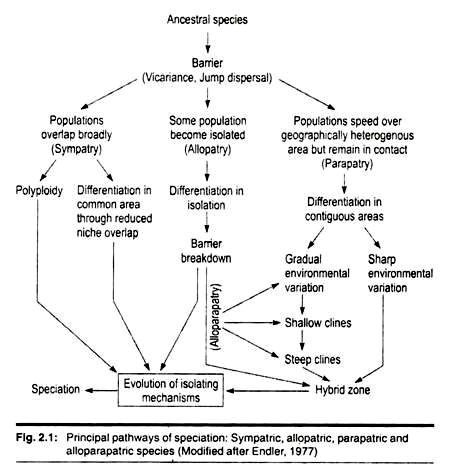This article throws light upon the four main categories of Speciation. The categories are: 1. Allopatric Speciation 2. Parapatric Speciation 3. Sympatric Speciation 4. Alloparapatric Speciation.
Category # 1. Allopatric Speciation:
Allopatric speciation occurs when the new species evolves in geographic isolation from the parent species. The species range, becomes subdivided by a barrier such as a new mountain range or the change in the course of a river.
Gene flow between the two subpopulations becomes impossible allowing evolution to proceed independently in each. Natural selection may favour different genotypes on either side of the barrier and random genetic drift and mutation could contribute to divergence.
Over time, divergence may proceed to the point that were the two populations to meet again, they would not be able to interbreed and speciation would be complete. This form of speciation may take place most readily in small populations at the extreme edge of a species range. The peripheral population could become isolated, for example, during contraction of the main species range in response to changing climate.
The isolated population would be subject to the founded effect and could be genetically different from the parent population. The combined effect of a small atypical population and extreme environmental conditions can cause rapid and extensive genetic reorganization through random genetic drift and strong natural selection, or, in other words a genetic revolution.
Category # 2. Parapatric Speciation:
This form of speciation occurs where the speciating populations are contiguous and hence only partially geographically isolated. They are able to across a common boundary during the speciation process. Where a species occupies a large geographical range it may become adapted to different environmental (e.g. climatic) conditions in different parts of that range.
Intermediate or hybrids, will be found but the large distances involved prevent the two types from merging completely.
For example, the herring gull Larus argentatus is a ring species whose distribution covers a large geographical area. Westwards from Britain toward North America its appearance changes gradually, but it is still recognizable herring gull. Further west in Siberia it begins to look more like the lesser black-backed gull Larus fuscus.
From Siberia to Russia and into northern Europe it becomes progressively more like the lesser black-backed gull. The ends of the ring meet in Europe and the two geographical extremes appear to be two good biological species.
Category # 3. Sympatric Speciation:
Sympatric speciation describes a situation where there is no geo- graphical separation between the speciating populations. All individuals are, in theory, able to meet each other during the speciation process. This model usually requires a change in host preference, food preference or habitat preference in order to prevent the new species being swamped by gene flow.
Whether sympatric speciation happens at all is a contentious issue. In theory it can occur where there is a polymorphism in the population conferring adaptation to two different habitats or niches. Reproductive isolation could then arise if the two morphs had a preference for ‘their’ habitat.
There is some evidence for this in natural populations. For example, caterpillars of the ermine moth, Yponomeuta padellus, feed on apple and hawthorn trees. Females prefer to lay their eggs on the species on which they were raised.
Caterpillars also prefer to feed on the plant on which their mothers were raised and adult moths prefer to mate with individuals from the same plant. The apple and hawthorn types are not completely isolated, but may represent an intermediate point in on-going sympatric speciation.
An un-contentious example of sympatric speciation occurs in plants through polyploidy. Polyploidy is the spontaneous duplication of the entire genome resulting in an individual with a multiple of the original chromosome number. Polyploidy is common in plants, where it often results in larger, more vigorous forms.
It is usually fatal in animals, although some amphibians are polyploids. The polyploid plant is no longer sexually compatible with the parent population but is able to establish a distinct population which may occupy a different habitat. The sand dune grass, Spartina townsendii, is a polyploid derived from the original S. anglica. It is more vigorous than the parent and has colonized large areas of sand dune in Britain.
Category # 4. Alloparapatric Speciation:
It is specialised kind of speciation where differentiation in isolation takes place through barrier breakdown processes, as influenced by gradual environmental variation. The details of different kinds of speciation mechanisms are shown in Fig. 2.1.
Most of the biologists believe that proto cells i.e. primitive life form gave rise to prokaryotes and that these in turn evolved into more complex protists, fungi, plants, animals and even man that make up the earth’s stunning biodiversity (Fig. 2.2).

